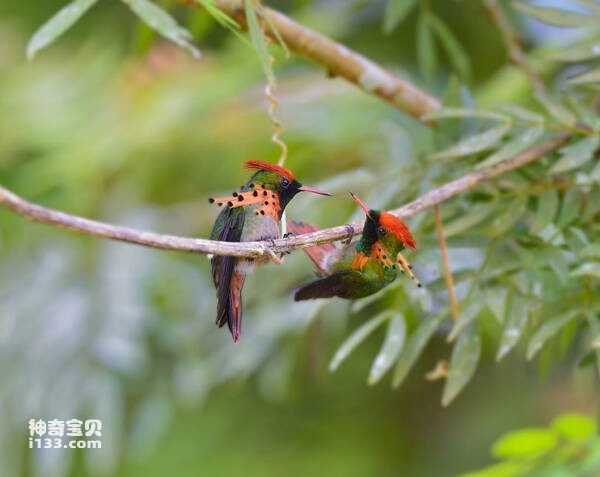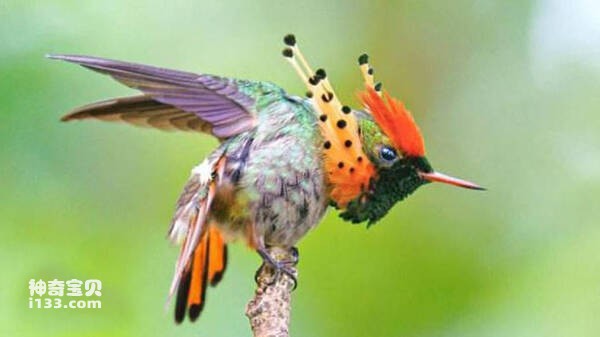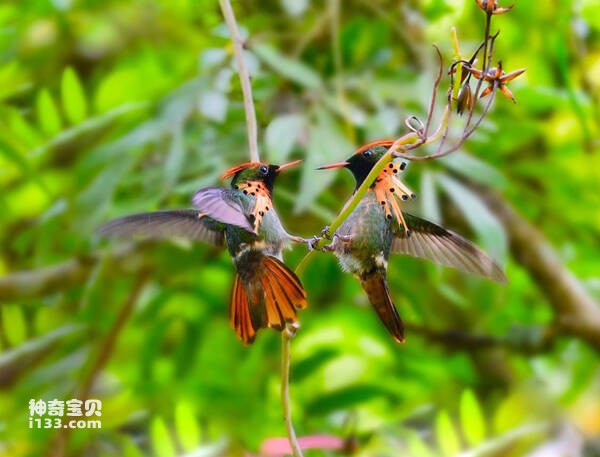Lophornis ornatus
IUCN
LCBasic Information
Scientific classification
- name:Lophornis ornatus
- Scientific Name:Lophornis ornatus,tufted coquette
- Outline:Climbing birds
- Family:
Vital signs
- length:6.6-8 cm (including tail length)
- Weight:About 2.3g
- lifetime:No textual research information is available
Feature
Orange or red feathers on the crown and cheeks are the main features of the bird, which appear metallic when exposed to sunlight
Distribution and Habitat
Origin: Brazil, French Guiana, Guyana, Suriname, Trinidad and Tobago, Venezuela.
Breeding colonies are found in eastern Venezuela, Trinidad, Guyana and northern Brazil.
It inhabits the edges of wet forests, shrubs and savannas, as well as cultivated areas such as gardens and plantations. It is found in open areas.
Appearance
The male's bill is short and straight red, with a black apex. There are several tufts of dark brown or orange feathers radially extended on the side of the neck, with black spots. Crown dark brown or orange. The back is copper-green, with white stripes on the waist and side. Green forehead and underfeather. The tail feathers are reddish brown with metallic luster.
The female does not have dark brown or orange feathers on the side of the neck, nor does she have a crest, which is all green. Underfeather reddish brown. The abdomen is light in color. Tail coppery green, mixed with dull markings, tail white.
Male juveniles resemble females but have a white throat with dark spots. White waist; The forehead is reddish. Young birds near maturity have tiny fringes on their necks.
The average body length of adult birds is 6.6~8cm (including tail length); It weighs about 2.3g.
Details
The crofted hummingbird (Lophornis ornatus) is tufted coquette, no subspecies。

Crown-topped hummingbirds feed primarily on the nectar of a variety of brightly colored, fragrant flowers that grow on trees, herbs, shrubs, and epiphytes. Favoring nectar with high sugar content, it can pick out flowers with high energy content in a certain area and guard them specifically. Hovering with their tails up, their long, straw-like tongues pick up nectar, licking up to 13 times a second. Occasionally they hang from flowers during feeding.
Crowning hummingbirds visit local hummingbird feeders that provide sugar water, hover or perch on the edge of a sink or sprinkler, and sip from it. They also prey on small spiders and insects to ensure an adequate supply of protein, especially during brooding, to ensure the normal growth of their young. It usually attacks insects in flight, but also those stuck in branches or spiderwebs. During the nesting period, the female catches up to 2,000 insects per day.
Male birds delimit their hunting areas and drive away other males and large insects (such as bumblebees and moths) that intruder into their territory. They protect their territory by flying and threatening. The bird migrates locally and seasonally in its native range.

Crested hummingbirds are solitary species that pair up during breeding. The male flies in a "U" shape in front of the female. After mating, the male flies away immediately. Males do not participate in the selection of nesting sites and the rearing of their young. The female birds nest alone. The nest is cup-shaped and made of plant fibers. It is decorated with moss for camouflage. The whole nest is placed in a hidden thicket or small tree (on a fork about 2 meters from the ground). The bedding material is usually soft plant fibers, animal hair and down, and is reinforced with spider silk and other adhesive materials to give the nest twice the flexibility to expand and leave enough room for the future growth of the chicks.
The average clutch lays 1 to 3 eggs (usually 2), and the eggs are white. The eggs are incubated by the female for 13 to 14 days. The male is responsible for guarding the nest. The newly hatched chicks are immobile with their eyes closed, and the female takes care of their diet (which consists mainly of semi-digested insects, as nectar does not provide enough protein for the chicks) by feeding food down their throats with a long beak so that it can fall directly into their stomachs. Similar to other hummingbirds, the chicks are only cared for by their parents for a week or two, and then abandoned in the nest, and even have to survive about 12 days of cold nights alone. The chicks are fully feathered 19 to 20 days after birth and can leave the nest.

The global population of thimble Crown hummingbirds has not been quantified but is a rare species in its place of origin (Stotz et al. 1996). Based on the Amazon forest harvesting model, with the duration of three generations (12 years) as the parameter, it is estimated that the habitat of the crown-crowned hummingbird decreased by 3.2-4.2% and the population decreased by nearly 25% during this period (Soares-Filho et al. 2006, Bird et al. 2011).
Listed on The IUCN Red List of Threatened Species: Not Threatened (LC), 2012 assessment.
Protect wild animals and eliminate wild meat.
Maintaining ecological balance is everyone's responsibility!








